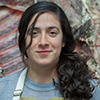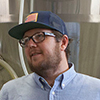



Shelke runs Corvus Blue LLC, a Chicago-based food science and research firm. The PhD has consulted on product development with numerous food manufacturers, including Ben & Jerry’s.
Interview by Mike Sula
Photos by Jeffrey Marini

Every festive occasion in our family generally started with the feeding of the disadvantaged. I was barely three when I learned that not everyone grew up with an abundance of food, and I resolved then to find a way to feed the world. My idea was to teach people about food and nutrition. Tasty, healthful foods should be a human right and not a privilege.
From when I can remember, I marveled at the ingenuity of my grandmothers. Our summer holidays were spent with one grandmother, and the winter with the other, and they always culminated with care packages so my mom could reproduce their recipes through the remainder of the year. My grandmothers’ culinary skills were astounding, and so was their understanding of the science of taste and food preservation. One bite of my mother’s reproductions evoked nostalgia like nothing else could.

Being a food scientist means to apply the principles of science to foods that are produced, used, stored, and disposed. My background in chemistry, food technology, and nutrition gives me an advantage in terms of the physiological and health effects of foods, from not only their components but also on the basis of how they’re made and handled.
Part of my work involves researching and experimenting to solve problems in food and nutrition and to create foods that are tasty, nutritious, affordable, convenient, and safe. Recently I helped develop a high-protein, high-fiber pasta from a single ingredient—lentils—so it also happens to be gluten free, but doesn’t have the nutritional deficiencies of most gluten-free products in the marketplace.
I specialize in ingredients: discovering and creating new ingredients; testing them for efficacy, functionality, and for safety; scaling them up for manufacture; ushering them through regulatory clearance; developing products using them; and educating the industry and the marketplace, which includes consumers and the media.


The maraschino cherries in [Ben & Jerry’s] Cherry Garcia used to be manually sorted for pits that escaped the packer’s notice. The sorting process involved repetitive motion and caused carpal tunnel issues. I introduced aseptically packed maraschino cherries that were pit free. Aseptic packaging also removed the need for benzoate preservative, making Cherry Garcia suitable for several international markets, such as France.
Phish Food, Ben’s version of Rocky Road, is the only one with a thick ribbon of marshmallow that stays gooey even when the ice cream is frozen. The technology I started for the ribbons of marshmallow that would stay gooey has since been advanced into gooey swirls of caramel, fudge, and jam in several Ben & Jerry’s offerings. You know that kid that says, “I see dead people”? I see ingredients, and I know what they do.

I am often called upon to advise and to testify as an expert in food industry litigations. A beverage company launched a sugar-sweetened version of its sugar-free products, which showed spoilage before its expiration date. The new product was not refrigerated (like its sugar-free counterpart), and bottles were popping in the warehouse and on store shelves due to fermentation. The company charged its bottling partner with unsanitary practices as the reason for the spoilage. My forensics analysis showed that the spoilage was not because of unsanitary bottling facilities, but because of an inadequate food-preservation system. The beverage company had simply added sugar to its sugar-free formulations, and had not optimized the formulation to counter microbial spoilage. I was able to show that the bottling company maintained high hygiene standards, and that the beverage company needed science-based formulation to make the new product enjoyable and safe.
Every company I worked for, I prepared them for acquisition. When companies want to be acquired, they bring me in, because they know that I know how to make them more attractive. A question I am always asked is “Here is our flagship product. We’re very proud of it. Can you help us make it cheaper?”

It’s not a sexy job. It’s a job where you come in and people hate you because you’re trimming things, and they’re looking at Is she going to trim me out of the job? I look at it purely from the process in a product.
With humans, food is a part of enjoyment. It is part of our emotional makeup. We eat our food with our eyes, with our nose, with our emotion before it even gets to our mouth. And it is part of our daily life. A food is a connecting thing. The problem is, Americans don’t cook! Americans don’t know how to cook, and many don’t cook.
I am terrified at eating bad-tasting food. I am literally afraid of it. I will not touch bad food.






















